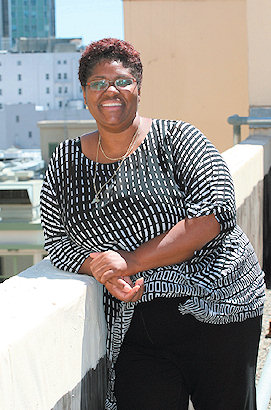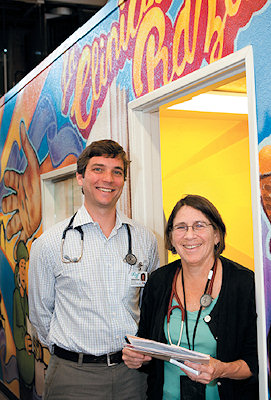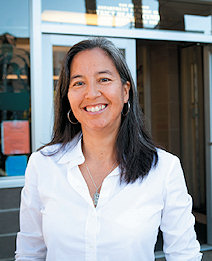Stories: Nursing Leadership in Adolescent and Young Adult Health (NLAYAH) Program
Improving Care for Underserved Adolescents and Young Adults
- While lighting oil pots to prevent crops from freezing, a 20-year-old agricultural worker is badly burned. No one has trained him how to do the job safely, and he was too intimidated to ask. Permanently scarred, both physically and emotionally, the man remains reluctant to reenter the work force.
- When she's excused from a high school project about motherhood, because her teacher makes some well-meaning, but incorrect assumptions about her condition, a 16-year-old with spina bifida is emotionally crushed.
- A 12-year-old transgender youth who has persistently identified as male since early childhood becomes distressed when “his” menstrual cycle begins. He seeks medical help to transition physically, but his physician tells him he has to wait until he's at least 16. The intervening years, including a suicide attempt, cause emotional scars that will alter the course of his adult life.
“The health care system might treat them either as large children or full-grown adults, but research increasingly recognizes that adolescents and young adults face uniquely complex health challenges,” says Susan Kools, NLAYAH project director.
Because today's health care system doesn't recognize the uniqueness of teens and young adults, Kools and other health care professionals believe that these young people often don't receive the care they need; this is especially true for teens from traditionally underserved groups. “Many have no insurance, and there are a lot of health disparities,” says Erica Monasterio, project coordinator of NLAYAH.
“The teaching in NLAYAH comes from a broad view of population and programs because adolescents cannot be served in silos; you have to meet them where they are and provide a range of services,” says Monasterio. As an example, she notes that it is common for a young person to show up at a primary care provider's office with concerns about acne, but also to have a number of unspoken concerns that can include depression, alcohol use and sexual health. “With adolescents and young adults, so many things are in flux at the same time,” says Monasterio. “A physician or advanced practice nurse in this position needs to not just know primary care, but have an awareness of other concerns young people have and a working relationship with other health professionals who can help meet those needs. This is a real nursing view, very holistic.”
A Focus on Leadership
In addition, says Kools, because better serving teens and young adults implies systemic change, NLAYAH focuses on developing leaders in the field. “We have a lot of excellent nurses, but many have not been trained to be successful leaders who can navigate the system and advocate for change,” she says.
To help them develop these leadership skills, NLAYAH trainees have completed projects that include:
- Working on an adolescent obesity treatment protocol at UCSF's interdisciplinary Weight Assessment for Teen and Child Health Clinic.
- A poster presentation at the Society for Adolescent Health and Medicine annual meeting in 2010.
- Fieldwork in rural Malawi (Africa) to develop a pilot study on the psychosocial needs of orphaned adolescents.
- Educating providers about the sexual lives of youths with disabilities.
- Participation in the development of a “Sexual Health Toolkit” for providers.
Young Adults and the Workplace Conundrum
As clinic manager at San Francisco Glide Health Services and a PhD student at the UCSF School of Nursing, Karen Hill has already distinguished herself as a leader in multiple ways.
Nevertheless, she is grateful that she is this year's funded PhD trainee for NLAYAH because of the support it offers as she focuses her doctoral work on helping older adolescent workers (ages 18-24) avoid work injuries.

Research has demonstrated that not only are such injuries more common in this population – especially because they are unprotected by child labor laws and often work jobs without insurance – but the injuries can also be permanently disabling, both physically and emotionally.
Hill's research is tied directly to her work at Glide. After Hill was enlisted to do drug testing for a Glide vocational training program, her encounters with the program's at-risk adolescents opened her eyes to the challenges they face.
“They had no real health promotion information, little access to primary and mental health services, and did not know how to use the services when they did,” she says. “I had these nursing students here and thought, Wouldn't it be great if we started a health education class for these young people?”
Aided by a booklet from the Adolescent Health Working Group – a coalition of youths, adults, and representatives of public and private agencies in San Francisco – Hill has grown an initial pilot project into an 11-week cycle for at-risk young adults in San Francisco.
The program and her interactions with the young adults caused Hill to think about their futures and their work lives. As she examined the research, she became convinced that work safety is a hidden, but powerful issue for this population. “It's especially an issue for disadvantaged and marginalized populations who live in urban neighborhoods,” says Hill.
“They may be pushed into jobs because of need, but they have less work experience, less social support, less training. There's the whole problem of an undeveloped frontal lobe, which makes them impulsive. They look like adults, but in the workplace, they may not know to ask about training or safety, might be too intimidated to ask, and often when they do report concerns, those concerns are minimized. Also, too often their families can't help, as they are just grateful their children are working.”
What's especially frustrating, says Hill, is that about 30 percent of people who suffer work-related injuries wind up with a chronic problem – and that often, the injury could be prevented with some education and awareness. “We need developmentally appropriate safety training for teens and young adults, as well as education for parents, primary care providers and employers,” she says. “More importantly, the public needs to know about this.
I'm hoping to be a spokesperson with all of these groups because those first experiences can color how a kid feels about work. They should be positive experiences and take advantage of the positive things young people can bring to a workplace.”

High School Health Center Delivers Broad Experience
NLAYAH trainee and Advanced Practice Pediatric Nursing student David Drevno, joins faculty and former trainee, Tara Valcarcel on the development of a distance learning module: “Transitions to Adulthood for Adolescents with Special Health Care Needs.” Drevno, who, like Valcarcel, is interested in working with young people who have chronic conditions – is slotted for a busy fall.
In addition to working on the distance-learning course, Drevno will complete a clinical rotation at San Lorenzo High School Health Center with Naomi Schapiro, who is a UCSF Clinical Professor supported by the NLAYAH grant. Schapiro's work at the health center represents a unique collaboration among UCSF, San Lorenzo High, Alameda County Health Care Services and la Clínica de la Raza, which operates the center.
School health centers are increasingly at the forefront of the “meet-'em-where-they- are” character of delivering care to adolescents that NLAYAH advocates.
Schapiro notes that the close, daily access to clinical services facilitates better case management of the multiple and complex concerns, creates opportunities to address issues such as mental health and sexuality, and even improves attendance, since students do not have to leave school for their medical appointments.
As such, Schapiro believes that Drevno's time at San Lorenzo High is an opportunity. “It gives someone like David, with his focused interest in chronic disease, a chance to see the full spectrum of teenage health concerns,” says Schapiro. “I feel confident it will further my knowledge of adolescents and help me better care for patients I plan to serve in the future,” says Drevno.
Crafting Primary Care Protocols for Transgender Teens

In 1998, Dafna Wu helped found San Francisco's Dimensions Clinic, one of the country's few clinics that, according to its website, serves “queer, transgender and questioning youth from ages 12 to 25.”
From her work in the clinic, where transgender young people arrive from all over the world, Wu has come to believe that they find it particularly difficult to find responsive health care. The problem, she says, is that in many cases, transgender youths know they are meant to be a particular gender from a very young age, but are unable to address this critical part of who they are because most providers cannot or will not help them make their desired transition.
“We frequently get families saying they went to several doctors who didn't know how to help them,” says Wu. “In the best case, the physicians feel untrained and want to do no harm. But there is also tremendous prejudice.”
There's also the law. Unless the youths are emancipated, says Wu, without parental consent, no provider can help anyone younger than 18 transition. Even with parental permission, there is some controversy among providers about when it is acceptable to begin hormone treatments. Wu and her Dimensions colleagues believe such hesitation flies in the face of research indicating that these young people suffer devastating emotional harm when they are denied this transition. It is likely a factor in their increased risk for depression, substance abuse and suicide.
In contrast, at Dimensions – where by necessity providers have slowly and carefully developed protocols for working with these youths – Wu has seen more positive outcomes when providers and families have supported the transition. And this is what in 2008 motivated Wu, already a master'sprepared nurse, to apply to UCSF for a post-master's family nurse practitioner credential. “I wanted to play a greater role and provide more responsive care for transgender youth,” she says.
Once at UCSF, Wu enrolled in the NLAYAH program. For her previous master's thesis, she had conducted a survey of the few primary care providers across the country who would discuss their experiences caring for transgender youths. The NLAYAH grant encouraged her to submit her abstract for publication, which resulted in Wu presenting a poster at the 2010 Society for Adolescent Health and Medicine conference in Toronto. NLAYAH funded her attendance.
“NLAYAH gave me access to tremendous expertise,” says Wu. “I was very excited to have them recognize this work in such an open and supportive way.”
The presentation has led to Wu becoming part of a national team that is writing training protocols for working with this high-risk population. “We're bringing together expertise and literature to create a training module to take to other primary care providers,” says Wu.
- Return to the NLAYAH program web page
